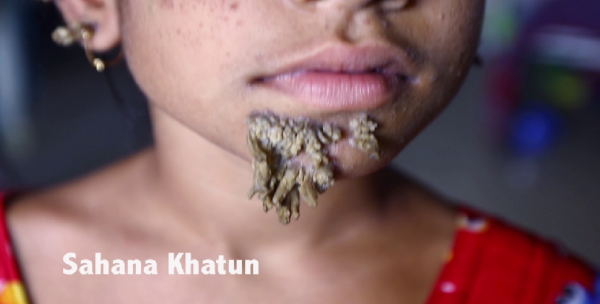By Dane Lorica, | February 05, 2017

The "Tree man syndrome" currently has no cure although surgical intervention is known to be effective. (YouTube)
A Bangladeshi girl is suspected to have the rare genetic "tree man syndrome," which had only affected men until her case was reported.
The 10-year-old girl named Sahana Khatun is the first female reported to have Epidermodysplasia verruciformis, a disease that fills the patient's body with bark-like warts. Sahana's father, Mohammad Shahjahan, first observed the presence of warts on her face four months ago. Its spread triggered them to consult a physician in Dhaka Medical College and Hospital.
Like Us on Facebook
According to the patient who resides in Kalmakanda, Bangladesh, she observed rashes on her skin eight years ago but did not see them as a major issue. "As they grew I became afraid but I didn't know where to find treatment," her father said.
Sahana's doctors hope that her condition is not severe. Dr. Samanta Lal Sen said, "we don't know yet if this is hundred percent a tree man syndrome, but it definitely is a variety of the epidermodysplasia verruciformis disease which causes very unusual skin disorder."
"We are very poor. My daughter lost her mother when she was only six. I really hope that the doctors will remove the barks from my beautiful daughter's face," the father said.
Sahana is currently undergoing testing to confirm the HPV infection. She added that since the signs manifested, her classmates changed their actions towards her. "They avoided me," she said.
The "Tree man syndrome" is caused by the Human Papilloma Virus (HPV) that commonly targets people with compromised immune system. People suffering from the condition develop scaly warts that appear like tree barks on their feet and hands.
Another patient who had the disease, Adul Bajandar, also from Bangladesh, successfully regained the functionality of his hands following 16 surgeries. His physicians removed 11 pounds of growth. An Indonesian man with the disease died in 2016. There were only four reported cases of the disease before Sahana's condition was disclosed.
The "Tree man syndrome" currently has no cure although surgical intervention is known to be effective.
-
Use of Coronavirus Pandemic Drones Raises Privacy Concerns: Drones Spread Fear, Local Officials Say

-
Coronavirus Hampers The Delivery Of Lockheed Martin F-35 Stealth Fighters For 2020

-
Instagram Speeds Up Plans to Add Account Memorialization Feature Due to COVID-19 Deaths

-
NASA: Perseverance Plans to Bring 'Mars Rock' to Earth in 2031

-
600 Dead And 3,000 In The Hospital as Iranians Believed Drinking High-Concentrations of Alcohol Can Cure The Coronavirus

-
600 Dead And 3,000 In The Hospital as Iranians Believed Drinking High-Concentrations of Alcohol Can Cure The Coronavirus

-
COVID-19: Doctors, Nurses Use Virtual Reality to Learn New Skills in Treating Coronavirus Patients







